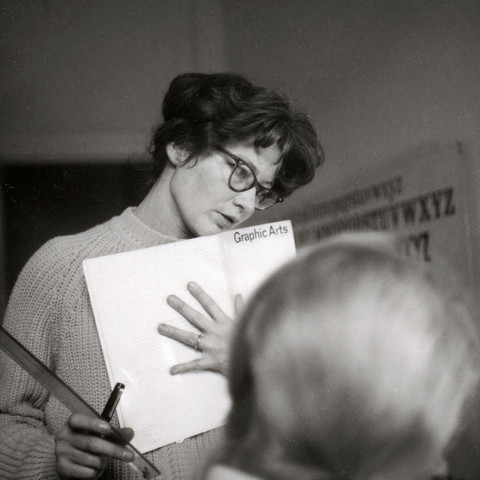Pat Grainger received a Medal of the Order of Australia (AOM) in the 2016 Queen’s Birthday Honours for service to history preservation. She was a founding member of the Port Melbourne Historical and Preservation Society in 1993, held the role of Treasurer for five years, and was the Society’s Secretary from 1998–2016.
Pat (Mason) Grainger neé Herman, born 1930, Spokane, WA, USA. Following a Whitman College BA in fine art and music theory, Pat studied ‘commercial art’ in L.A. While designing trendy ‘studio’ cards she took a day job in a small Sunset Boulevard agency where she was further trained by art director Les Mason. Her career became inextricably linked with his when in 1956 she and Les married.
Their plans for European travel fell through when Pat fell pregnant as the 1960 depression hit the design industry hard. An Australian ad for a designer caught their interest: Les had been there in WW2 and liked Sydney. With two former wives and sons to support, they decided to seek work in Australia. Their letter to a Sydney agency was widely circulated and offers came from both Sydney and Melbourne. On meeting Colin Uren in San Francisco as well as a Sydney representative, Les signed a year’s contract with Melbourne’s USP Benson. The family arrived on St Patrick’s Day, 1961.
By then they were four. Pat took a year off before joining Arthur Leydin, Wes Walters, Bruce Weatherhead, Garry Emery, Roy Hunt and photographer Eric Lang at Dimensions, where she specialised in typography and finished art.
With just six months of their obligatory two year stay to go, Les decided to leave the agency and open a studio for the remainder. Pat created the typography for Lyn Whaite’s ‘Williams the Shoeman’ series after he joined them.
The move ended travel plans. They bought a cottage and renovated it as Melbourne’s first serious graphic design studio, where Pat as typographer led a team of artists in executing concepts by Les and assistant designers such as David Hornblow and later Malcolm Smith.
In 1966 the Masons agreed to produce Allan Holdsworth’s Epicurean magazine for a token amount: with concepts, photography, illustration by Les, Pat on typography, page layouts and prop work, and the full team on other studio business. After ten issues, Les prepared spare photos and drawings and Pat briefed Allan on a basic typographical format before in 1968 they rented the studio to Weatherhead & Stitt, and the family spent a year travelling the world with a tent and a Combi. They met and sometimes stayed with leading European, American and Asian designers, and took in the Biennale, the Triennale, Documenta and the great museums. Les attended two design conferences, produced new Epicurean photos and drawings and even worked briefly with various studios while Pat prepared artwork to ship home, and Lou and Mary, 10 and 7, wrote on local culture. Over that year Les concluded there was more freedom for designers in Australia and it was the best place to be.
In 1972 Les left the family, and Pat soon left the partnership and went to work with Imagistics, designing multimedia productions with writer David Webster and photographer John Pollard. She found multimedia enormously exciting, as the design was in four dimensions. With original sets, and sound tracks by leading Australian composers, Imagistic productions were highly creative but highly ephemeral – six weeks of teamwork could go into a one-off performance.
With the competition producing quick formula shows for the same fee, Imagistics eventually went broke and Pat joined Cy Cater Advertising as art director. While at Imagistics, Pat had met Geordie Brian Grainger, visiting Melbourne to brief designers and typesetters on the new electronic typesetting. He recruited Pat as designer for his Melbourne studio, The Design Department; but Lionel Hunt and Gordon Trembath soon sought her work at Campaign Palace, and she joined them while continuing to design for Brian, who had become more than a business partner.
In 1977 Pat and Brian married in order to set up Cambridge studio Optimus with partner David Hornblow. Mary joined them, while Lou remained to study design and work with her father. Lou later joined the U.K. studio.
Pat returned to Melbourne after five years and took on the ‘sectored kerning’ of All Graphics’s digital fonts – until she was needed at Brian’s Melbourne studio Optimum Oz, and turned the kerning over to Mary.
Pat remained with Optimum Oz until it was sold to studio manager Bill Kerr and designer Frank Turco, then free-lanced as a designer and copywriter. Through community activism she became involved in local history, and since 1993 has designed publications and exhibitions and published several books on behalf of the Port Melbourne Historical and Preservation Society.
